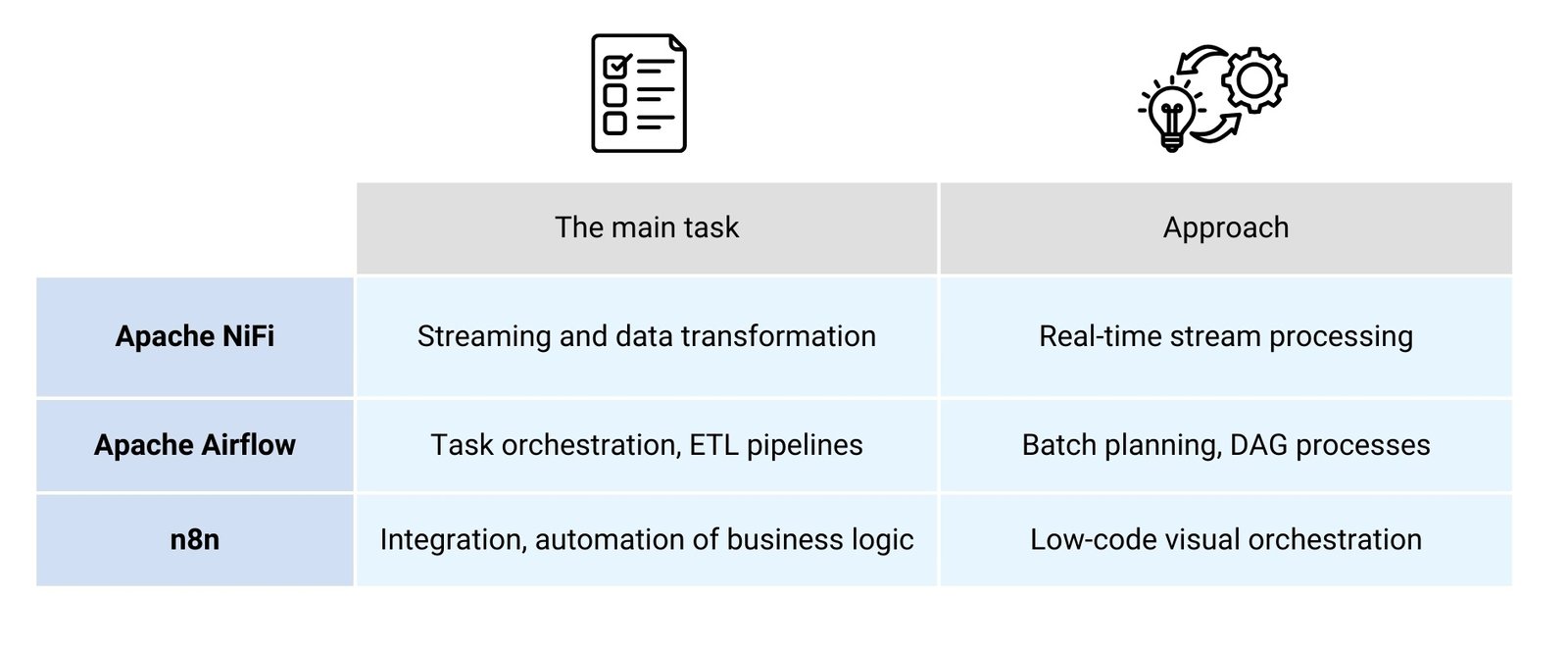n8n is an Open Source Low-Code / No-Code platform for building automated workflows, characterized by ease of use, flexibility and the ability to quickly integrate with a wide range of external services.
No-Code is a method of creating digital products without writing code. All elements of the process – from logic to interface – are realized exclusively with visual tools. No-Code platforms target users with no technical background and allow you to quickly create automations, forms, integrations and web applications. Example: a user configures automatic notification sending or Google Sheets integration through a drag-and-drop interface without programming knowledge.
With open source and local deployment capabilities, n8n in automation and ETL Pipelines creation processes gives companies complete control over their data while ensuring security and independence from cloud providers.
Unlike Apache Airflow, which is oriented toward computational tasks with tight orchestration and requires knowledge of Python, n8n provides a visual editor that allows scripting without requiring knowledge of programming languages (Fig. 7.4-6). Although its interface allows the creation of automated processes without writing code (No-Code), in more complex scenarios users can add their own JavaScript and Python -functions to extend the capabilities (Low-Code).
Low-Code is an approach to software development in which the basic logic of an application or process is created using a graphical interface and visual elements, and program code is used only to customize or extend functionality. Low-Code platforms allow to significantly accelerate the development of solutions by involving not only programmers, but also business users with basic technical skills. Example: a user can build a business process from ready-made blocks and, if necessary, add their own script in JavaScript or Python.
Although n8n is positioned as a platform with a low entry threshold, basic programming knowledge, understanding of web technologies and skills in working with API. The flexibility of the system allows it to be adapted to a wide range of tasks – from automated data processing to integration with messengers, IoT -devices and cloud services.
Key features and benefits of using the n8n:
- Open source and local deployment capabilities ensure complete data control, security compliance, and independence from cloud providers.
- Integration with over 330 services including CRM, ERP, e-commerce, cloud platforms, messengers and databases.
- Scenario flexibility: from simple notifications to complex chains with API processing of -requests, decision logic and connection of AI -services.
- Support for JavaScript and Python: users can embed custom code as needed, extending automation capabilities.
- Intuitive visual interface: allows you to quickly configure and visualize all process steps.
Low-Code class platforms provide tools to create digital solutions with minimal code, making them ideal for teams that don’t have deep technical expertise but need to automate processes.
In construction, n8n can be used to automate a variety of processes such as integrating with project management systems, streaming inspections, writing out-of-the-box reports and letters, automatically updating material inventory data, sending task status notifications to teams, and more. A customized Pipeline in n8n can reduce manual operations by multiples, reduce the likelihood of errors, and speed up decision making for project execution.
You can choose from nearly two thousand off-the-shelf, free and open source n8n Pipeline, available at: n8n.io/workflows, to automate both construction workflows and personal tasks, reducing routine operations.
Take one of the ready-made Pipeline templates, available for free at n8n.io (n8n, “Gmail AI Auto-Responder: Create Draft Replies to incoming emails,” May 1, 2024), whichautomatically creates draft responses in Gmail (Fig. 7.4-6), helping users who receive a high volume of emails or have difficulty composing responses.
This n8n “Gmail AI Auto-Responder: Create draft responses to incoming emails” template (Fig. 7.4-6) analyzes incoming emails using LLM from ChatGPT, determines if a response is needed, generates a draft from ChatGPT and converts the text to HTML and adds it to the message chain in Gmail. This does not automatically send the email, allowing you to manually edit and approve the response. Setup takes about 10 minutes and includes OAuth configuration of the Gmail API and OpenAI API integration. The result is a convenient and free solution for automating routine email communication without losing control over the content of emails.

Another example of automation with n8nis finding great deals in the real estate market(n8n, “Real Estate Daily Deals Automation with Zillow API, Google Sheets and Gmail,” 1 Mar 2025).N8n Pipeline “Automating Daily Real Estate Deals with Zillow API, Google Sheets and Gmail”, collects daily relevant offers matching specified criteria using Zillow API. It automatically calculates key investment metrics (Cash on Cash ROI, Monthly Cash Flow, Down Payment), updates Google Sheets and sends a summary report to email (Fig. 7.4-7), allowing investors to save time and respond quickly to the best offers.

With its flexibility and extensibility, n8n becomes a valuable tool for companies seeking to digitally transform and become more competitive in the marketplace with relatively simple and free open source tools.
Tools such as Apache NiFi, Airflow, and n8n can be thought of as three layers of data processing (Fig. 7.4-8). NiFi manages the flow of data, ensuring its delivery and transformation, Airflow orchestrates task execution by aggregating data into processing pipelines, and n8n automates integration with external services and manages business logic.

Together, these free and open source tools potentially form an example of an effective ecosystem for data and process management in the construction industry, allowing companies to leverage information for decision making and process automation.


















